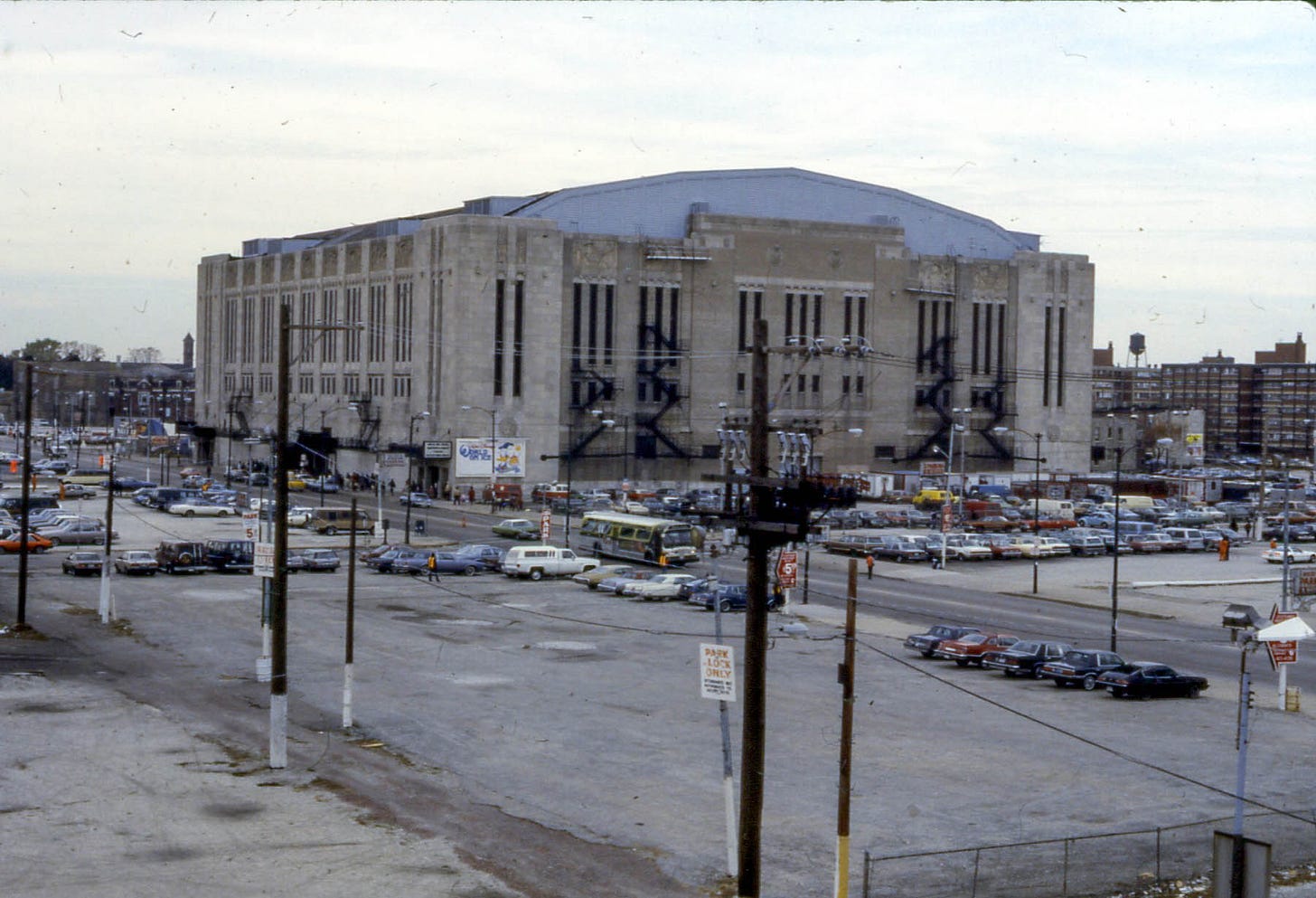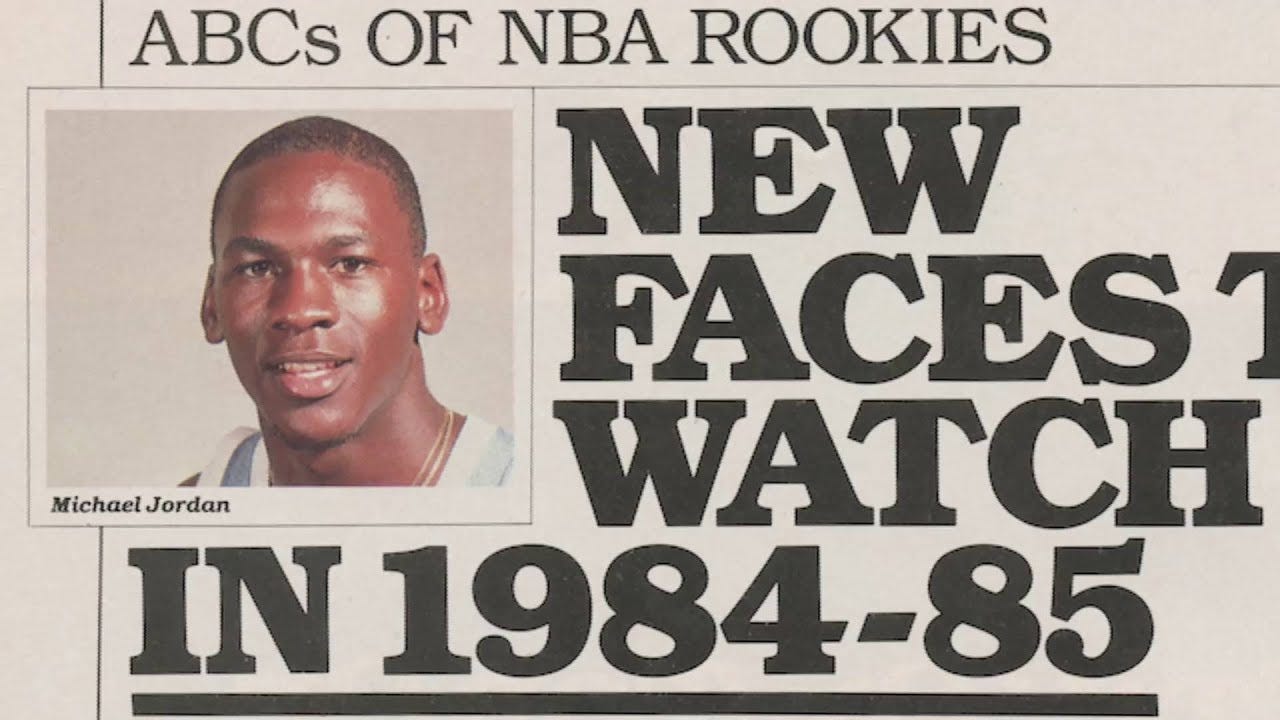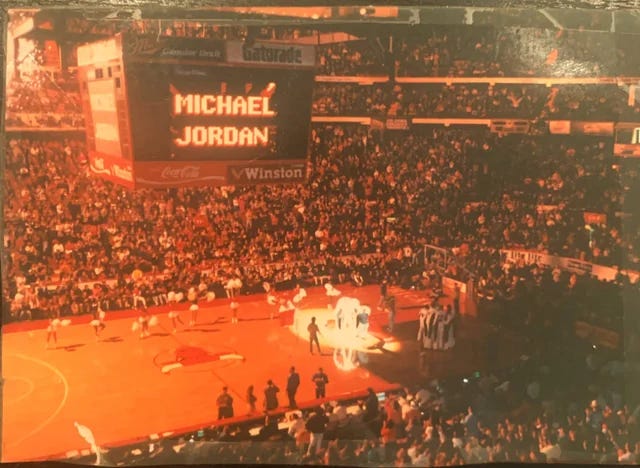The Magic of Michael Jordan, Coby White, and the Chicago Stadium
In a decisive Play-In Game victory, the Chicago Bulls point guard channeled M.J., and for one evening, the United Center felt as electric as the old Chicago Stadium.
Transcendence generally isn’t an adjective you associate with the Chicago Bulls point guards of the last decade-plus.
The last time the Bulls were lucky enough to have an inspiring floor general was the 2011-2012 regular season, that floor general being a pre-injury Derrick Rose. (You sometimes forget how damn fun peak D-Rose was.) Since then, it’s been a parade of competence, of okay-ness, of averageness, a parade featuring the likes of Michael Carter-Williams, Goran Dragić, Kris Dunn, Cameron Payne, Shaq Harrison, late-career Rajon Rondo, and Ryan Arcidiacono.
Decent enough players, but no transcendence.
Last night, Coby White ended the transcendence drought.
The North Carolina product had his way with the literally and figuratively defenseless Atlanta Hawks, twisting and Euro-stepping his way to a career-high 42 points on 15-21 shooting, and leading Chicago to a 131-116 statement win — although statement is a relative thing, as Atlanta had exactly zero interest in playing defense. For that matter, save for their gritty second quarter, it looked like Atlanta had zero interest in playing, period.
Listen, I’ve been to a heck of a lot of Bulls games over the past (fill in the blank) decades, and I can count on one hand the number of times the United Center felt alive.
There was this epic 2009 playoff contest against the Boston Celtics:
And there was this heartbreaking 2005 playoff lost to the Washington Wizards:
And, um, that’s pretty much it.
Conversely, the Chicago Stadium was almost always electric.
Between 1967 and 1994, the Chicago Bulls played their home games at the Chicago Stadium.
And the Chicago Stadium was a dump.
But it was our dump.
We loved the Stadium the way you love your untrainable dog — unconditionally, with moments of massive frustration. Frustration was merited, as the place had issues:
On game nights, the first thing we faced after making the 17.6 mile trek from the ‘burbs to the Stadium was a parking lot filled with loose gravel, yards-long cracks, and foot-deep Chicago-style potholes.
When we strode up the ticket booth — back in the day, we were able to buy tickets at the door, and good tickets at that — there was always a surly cashier awaiting us.
The creaky hallways smelled like a combo platter of old popcorn oil and high school locker room…and sometimes, after the annual appearance by the Ringling Bros. and Barnum & Bailey Circus, it was eau de elephant.
The tunnels leading into the seating area were half-lit due to the Stadium staff’s neglectfulness re: burnt-out light bulbs.
The paint-chipped seats were barely anchored, and the floors were sticky with spilled Schlitz beer from the previous night’s Blackhawks game.
It should probably be noted that the place was built in 1929. But still.
In the early 1980s, Chicago’s on-court basketball product was as iffy as its surroundings — but it was our iffy on-court product, so we dealt with it.
Between 1981 and 1986, the franchise’s winning percentage was .382 (yuck). Even with a roster that was coached for a bit by Hall of Famer Jerry Sloan, the 1981 squad could only manage a record of 34-48. Sloan was let go midway through the ‘81 season after compiling a record of 19-32 — but to be fair, even Red Auerbach would’ve had trouble approaching .500 with a roster comprised mostly of, oh, let’s go with defensively-challenged wings like Reggie Theus, David Greenwood, and Orlando Woolridge.
And don’t get me started about the drug problems.
When the Bulls played at home, the fans stayed away in droves, in part because they were fed up with the entire Chicago sports scene, such as it was:
Aside from watching Walter Payton do Walter Payton things, the Bears were hard to stomach until 1984.
Apart from a magical 1984 season that ended in tears (read: Leon Durham), the Cubs were their usual heartbreaking selves.
The White Sox were an interesting team — for instance, the majority of their starting pitchers were lefties, and the majority of their home run hitters (Carlton Fisk and Ron Kittle, most notably) had zero muscle tone — but they were the White Sox, and, let’s be honest here, the vast majority of Chicago sports watchers in 1979, or 1980, or 1981, and so on weren’t watching the White Sox.
As for the Blackhawks, they were a consistent playoff team, but their fan base consisted solely of the 20,000 people who attended their home games at the Stadium.
And then there was the city itself.
The national recession had hit Chicago hard. Between 1979-1989, the work force decreased by 2.8 percent, and thousands of employees were laid off, from doctors and nurses, to mass transit workers.
The traditionally segregated city’s racial divide had entered uncharted territory, as Harold Washington was elected as mayor, the city’s first ever African-American leader. Washington is now a beloved figure in Chicago, but at the time, he earned mixed reviews at best, further muddying the city’s oftentimes messy racial mojo.
It wasn’t an ideal time to be a Chicago sports lover. Or, for that matter, a Chicagoan.
Our city — a city that, despite the problems, we adored with all our hearts — needed something. We just weren’t sure what.
The 1983-84 Bulls posted a record of 27-55, at the time the second-worst in franchise history. During an NBA era in which defense was optional, they could manage only 102.4 points a game, good (or bad) for 20th in the league. Their roster was filled with reluctant rebounders — center Dave Corzine was the only player to average more than 7 boards a night — and Woolridge was their lone regular rotation player to put up a field goal percentage that topped .500.
Nonetheless, we trekked out to that jacked-up stadium, despite the fact that it was an Isle of Misfit Hoopsters.
On the plus side, entry into the Isle of Misfit You-Know-Whats was dirt cheap, and unless the Bulls were hosting a top-shelf squad, we had our pick of seats. Since the sight lines in the lower level of the Stadium were suboptimal, the first row in the first balcony was our favorite place to sit. Tickets were easily accessible that a center-court seat up in the 200 section — which, today, costs upwards of $150 — and set us back a mere ten bucks. It eventually rose to $15.00.
The Association had more than its fair share of greats, and we took advantage. We watched our hometown semi-heroes lose to, among others, Isiah Thomas’ Detroit Pistons, Sidney Moncrief’s Milwaukee Bucks, and, of course, Larry Bird’s Boston Celtics.
Those 1983-84 Bulls finished with the second-worst record in the league, which led to them owning the third pick in the draft, and man, the 1984 draft class was stacked.
We’d watched Akeem Olajuwon do scary things at the University of Houston, and goodness gracious, did we want to see him in a Bulls uni. We were all but certain he’d be gone before we picked, but we were cool with that (sort of), as we would’ve been content landing either of the studs from North Carolina, Michael Jordan or Sam Perkins…but, to our credit, we thought that Jordan had more upside. (We also dug Auburn’s Charles Barkley, but we were concerned about his lack of height and excess of blubber.)
The only wild card was Sam Bowie, who none of us liked. The University of Kentucky center was slow, awkward, and fragile, but for some reason, a goodly number of NBA scouts thought he was going to be the next Bill Walton. We hoped and prayed the Bulls didn’t employ one of those particular talent evaluators.
Luckily for us, the Portland Trail Blazers — who had been looking for another Bill Walton since they had, y’know, Bill Walton — owned the second pick of the 1984 draft, so after the Houston Rockets, to nobody’s surprise, grabbed Olajuwon at one, the Blazers snatched up Bowie at two.
So Jordan to the Bulls it was. Which worked out pretty well.
Tickets at our venerable dump of an arena were easily accessible during M.J.’s rookie season, so we were able to catch plenty of games. We always made it a point to hit the Stadium when the Bucks — one of the unsung units of the era — came to town, as they were super-fun to watch, plus there was that whole border-state rivalry thing. (At the time, the cold war between Illinois and Wisconsin sports loyalists was intense — we despised the Green Bay Packers, and they despised the Bears. But they appreciated our pizza and we appreciated their bratwurst, so it was ultimately all good. FWIW, we still despise the Packers.)
More often than not, Michael was brilliant, but the team wasn’t, finishing the year six games below .500 — not pretty, for sure, but the league had its share of ugly franchises, so the Bulls were able to squeak into the postseason, where they faced those darn Bucks in the first round.
In what seems shocking now, we were able to score tickets for the series’ crucial Game 3 on the day of the contest. Jordan was brilliant throughout, racking up 35 points, 8 boards, 7 dimes, and 4 steals. Chicago native Terry Cummings was just as good for the Bucks, scoring 37 points on 15-of-20 shooting from the field, and 7-of-8 from the stripe.
To this day, we still reminisce about the end of that fourth quarter, when M.J. and Cummings traded basket after basket after basket. Turned out that Jordan hit the last one, so the Bulls squeaked out a 109-107 win. The memory of that grueling one-on-one battle remains one of our most cherished from the Madhouse on Madison, Version 1.0.
Here’re some random early-career M.J. moments from the Stadium that, decades later, still remain etched in the NBA chamber of our hearts:
November 10, 1987
Ld by the eternally-bouncy Dominique Wilkins, the Atlanta Hawks fell to the Bulls in a 94-92. nail-biter. Wilkins refused to stop chucking the rock — he threw up 28 shots, bricking 15 of them — so in the fourth quarter, every time he touched the ball, we’d scream “Shooooooot!” Our entire section picked up the chant, one of our proudest moments at the Madhouse.
February 20, 1987
Magic Johnson and his mighty Los Angeles Lakers visited the Stadium, one of the few games during the early Michael years at which tickets were at a premium. We had literally the worst seats in the house, those being third balcony, last row, corner, obstructed view. Jordan was in I’m-gonna-do-this-all-myself mode, scoring 33 points on a rough 11-of-27 shooting performance. On the other hand, five Lakers topped 15 points, and they stomped the Bulls 110-100, a score that didn’t reflect the game’s lopsidedness.
December 29, 1988
In one of our greatest evenings of basketball viewing, we watched Scottie Pippen tip in a buzzer beater to lift the red-and-black over the Patrick Ewing-led Knicks by a final of 108-106. The Jordan/Pippen tandem was brilliant that night, teaming up for 60 points, 15 rebounds, 10 assists, 4 blocks, and 4 steals. We had phenomenal seats for that one — lower deck, sixth row center — and after Pip’s game-clincher, we spiked our soda on the floor and hurled our programs into the air. We’re 90% sure the programs landed on the court, a massive win for us.
Those are just three of our classic moments from that dump of an arena.
We could probably write a whole book of ‘em.
If you’re an M.J. fanatic, you probably could too.
Yeah, the Windy City political landscape of the late-80s was still super-corrupt, and yeah, the national recession was still a thing, but M.J. — along with the suddenly-scary Chicago Bears — tangibly brightened Chicago’s mood. You see, Chicago is a Sports City — capital “S,” capital “C” — and when the teams are rocking, the fans rock right along with them. (That said, Chicago’s hardcore fans — of which I’m one, thank you very much — still rock when our teams stink, just not quite as hard.)
On November 4, 1994, the Bulls played their first regular season game at the United Center, a shiny new state-of-the-art arena that’s currently not as state-of-the-art as it used to be. Sure, it’s a perfectly functional barn, but it’s devoid of any Chicago Stadium-esque personality. It’s clean, there aren’t any burnt-out light bulbs, the bathrooms rate a solid B+, and it smells like overpriced tacos and deep-dish pizza.
It’s a snooze. We miss the Stadium.
Basketball-wise, Chicago’s on-court product, save for some mind-blowing DeMar DeRozan moments, hasn’t been transcendent for many, many years, and if the recent iterations of the Bulls were housed at a grungy place like the Stadium, it would be like the pre-Michael vibe all over again: We’d be able to easily get tickets at the door, and a third of the seats would be empty.
But when we were young, and when His Airness bounced off the ceiling night after night after night, that dump was the most beautiful building in the world.









